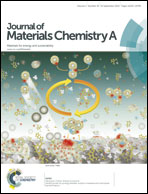Electrochemical behavior and surface structural change of LiMn2O4 charged to 5.1 V†
Abstract
Charging a spinel LiMn2O4 cathode material to high voltage (>4.3 V) is a convenient way to obtain more lithium ions for formation of an anodic solid-electrolyte-interface in a full cell. In this work, a LiMn2O4 spinel cathode material was charged to 5.1 V for only one cycle during normal cycling (3–4.3 V) to study the impact of high voltage on the electrochemical performance and structure. The electrochemical performance showed that more lithium ions were de-intercalated from the cathode structure during cycling between 3 and 5.1 V. However, even upon cycling to high voltage for only one cycle, the surface of the cathode demonstrated a drastic change in the atomic-level structure. Via an advanced scanning transmission electron microscopy (STEM) technique, the formation of a layered-like phase was directly observed on the surface of spinel LiMn2O4 charged to high voltage, implying the instability of the spinel structure at high charge voltage. This observation contradicts to the conventional wisdom that the spinel structure is more stable than the layered structure during lithium intercalation. X-ray photoelectron spectroscopy (XPS) results showed a small amount of manganese with lower oxidation states after being charged to 5.1 V, suggesting an accelerated speed of manganese dissolution.


 Please wait while we load your content...
Please wait while we load your content...